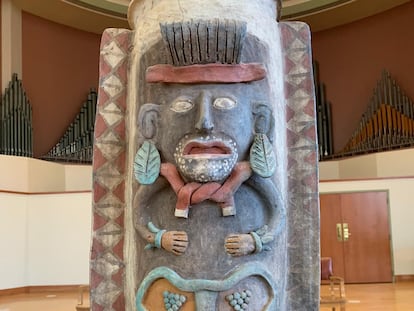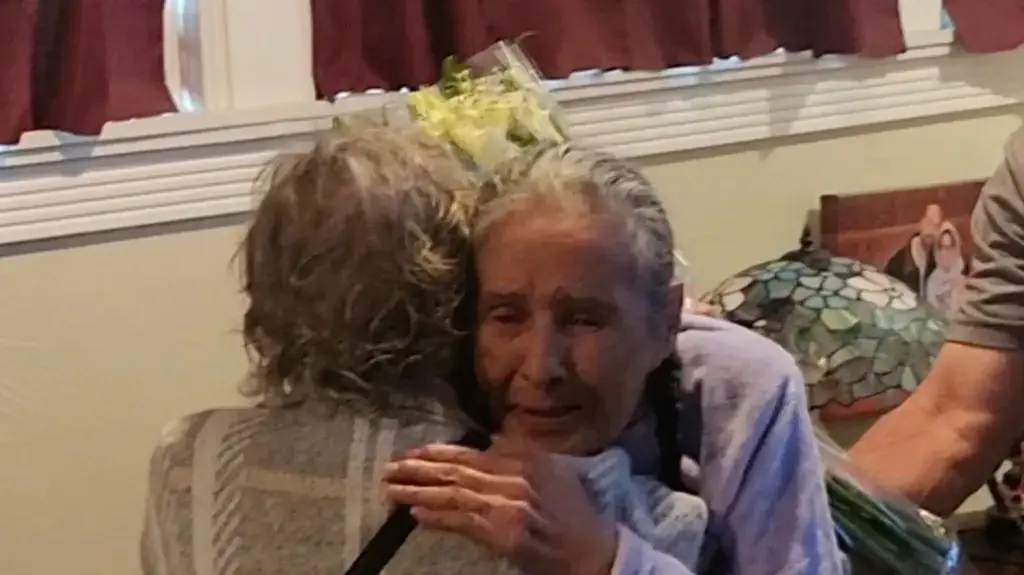The Mayan urn that is at Albion College in Michigan and will be repatriated to Mexico.inah / EL PAÍS
A perhispanic urn that the Mayans used to perform rituals in the territory of the current state of Chiapas, in southern Mexico, will be brought back to the country after 50 years.
The ceramic cylinder was found in 1969 in that area by Professor Marvin Vann, brought to the United States and donated in 2003 to Albion College in Michigan, where it has remained until now.
In the municipality of San Cristóbal de las Casas, its “twin” remained, a supposedly identical version that “was made with the same clay and, probably, by the same craftsman”, according to the researcher from the National Institute of Anthropology and History (INAH ) Josuhé Lozada, who participated in the negotiations for the return of the piece to the Latin American country.
It is "great", he values, because "the twin pieces are few in the Mayan world."
Negotiations to return the piece to "its own country" began in 2009, Elizabeth Palmer, the director of the Albion College Archives, explained in a college publication.
An expert professor in Mayan art, Joel Palka, had discovered that the urn was in those archives and that in Chiapas there was an identical one created between the year 900 and 1600. After carrying out several chemical analyzes, the researchers found that the urn was original, Pre-Hispanic and made with the same material as the one that was more than 4,000 kilometers away, in the Museum of Los Altos.
The sculpture will arrive in Mexico from Michigan “in a matter of days”, according to Lozada calculates, while photographs, documents and reproductions of objects that belonged to Professor Marvin Vann will remain in the American institution.
Lozada considers that the figure who will return to Mexico is "unique in iconographic terms" and will allow us to learn more about a little-known period of the Mayans.
The sculpture represents a god linked to commerce and the underworld and was built in clay in the Laguna Pethá area more than 400 years ago, explains the researcher.
In the upper part of the sculpture, where the head is located, the Mayans lit copal, an aromatic resin, and "initiated communication with the deity."
"For these Mesoamerican or pre-Hispanic cultures, these objects, as we call them in the West, were subjects," says the expert.
The smoke, he says, was the intermediary for making prayers and requests.
“We can imagine a dark cave and suddenly walk in and see a deity with smoke.
It must have been a very ceremonial environment ”, he recreates.
More information
Mexico recovers 280 pre-Hispanic pieces that were in the United States
The ballot box, he assures, is "an example of popular culture": "We have very few examples of a cylinder with these characteristics."
"The vast majority of archaeological investigations in the Mayan area have focused on the period of greatest flourishing, the late classic [between 600 and 900 AD] and are closely linked to the monumentality of the pyramids," says Lozada by phone. from Michigan, where this Tuesday an official ceremony was held for the repatriation of the urn.
The INAH expert explains that unlike cylinders from earlier times —the most famous are the censers of Palenque— this urn represents the entire body of the deity, not only the head and headdress, and also has a “monster” at its base. of the earth ”, called
witz
in Mayan, which represents the underworld.
"But the story does not end there", Lozada warns: "There is a third piece."
It is a representation of the goddess of the Moon that is in Cancun (Quintana Roo) and that the researchers consider that it was made with the same material as the other two, although it is not identical.
"Our wish is to bring all three together," says the archaeologist.
The expert considers that the transfer made by Professor Marvin Vann from Chiapas to Michigan was "a heritage conservation task" and not looting.
Lozada argues that when the piece left the country the Federal Law on Monuments and Archaeological, Artistic and Historical Zones of 1972 was not in force, which determines that pieces such as the urn cannot leave the territory without authorization from the INAH.
"Repatriations are not always sad stories," he says.
The researcher believes that the restitution of the piece "could be an example for other nations" —some 9,000 pieces of pre-Hispanic art are found distributed in museums in Europe and the United States, according to an investigation carried out in 2012 by specialist Miguel Gleason— and that recent negotiations between Albion College and the Mexican Consulate in Detroit "strengthen relations" between Mexico and the United States.
In March, the Latin American country had already recovered 280 pre-Hispanic pieces that were in the United States, mostly carved stone artifacts that were stolen from the territory currently occupied by the State of Sonora, in the northwest of the country.
Mexico promotes a crusade to recover the historical heritage that is distributed throughout the world.
In 2020, the writer and historian Beatriz Gutiérrez Müller, wife of the Mexican president, Andrés Manuel López Obrador, made a tour of Europe to request the temporary loan of some of these archaeological pieces to expose the artifacts during the anniversaries of the independence of Mexico (1821 ), the fifth centenary of the fall of Tenochtitlan [the pre-Hispanic precedent of Mexico City] (1521) and the foundation of the first towns in that city in 1931, which coincide this year.
Subscribe here
to the
newsletter
of EL PAÍS México and receive all the informative keys of the current situation of this country


/cloudfront-eu-central-1.images.arcpublishing.com/prisa/5UPDG5IW2NDDFFUK3WJTFKMSPE.jpg)






/cloudfront-eu-central-1.images.arcpublishing.com/prisa/VJEQPDZR7VGOFMRM3OPJZFFZJQ.jpg)